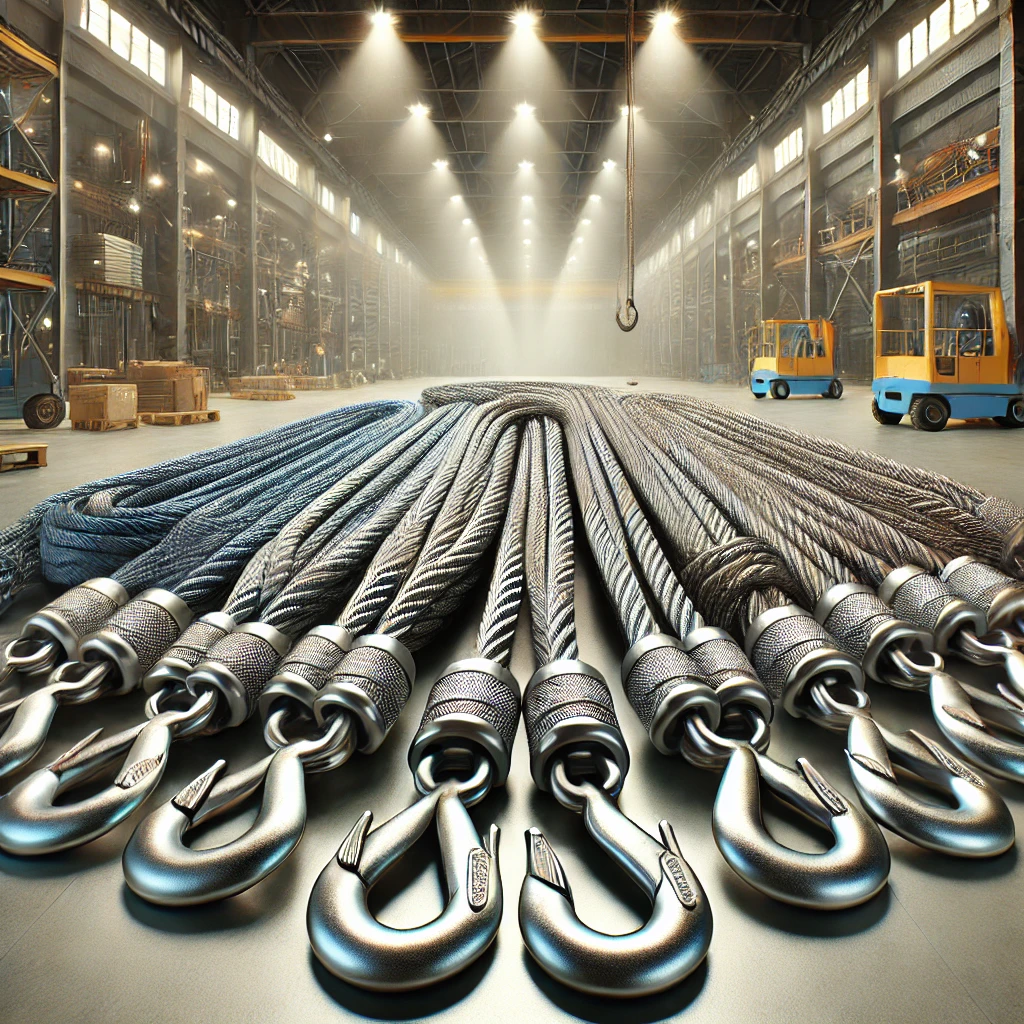Lifting slings are indispensable tools in industries that handle heavy loads, ensuring safe and efficient operations. They come in various types, including wire rope slings, web slings, and chain slings, each suited for specific applications. This comprehensive guide explores the construction, advantages, and uses of these slings, focusing on wire rope sling cores, web sling types, and chain sling variations to help you make informed decisions.
What Are Lifting Slings?
Lifting slings are flexible devices used to secure, lift, and balance loads. Their material, construction, and type determine their strength, flexibility, and suitability for specific environments. Among the most common types are:
- Wire Rope Slings – Durable and versatile for heavy-duty lifting.
- Web Slings – Lightweight and gentle on polished or delicate surfaces.
- Chain Slings – Extremely strong and resistant to wear, ideal for rugged environments.
1. Wire Rope Slings
Wire rope slings are known for their strength, durability, and ability to handle heavy loads. The core of the wire rope is a critical component, influencing flexibility, strength, and longevity.
Wire Rope Sling Core Types
a. Fiber Core (FC)
- Material: Natural fibers (sisal, hemp) or synthetic fibers (polypropylene).
- Features: Lightweight, flexible, and retains lubrication to reduce wear.
- Applications:
- Light-to-medium-duty lifting.
- Avoid high-temperature or high-load environments.
b. Steel Core (Independent Wire Rope Core – IWRC)
- Material: A smaller steel wire rope acts as the core.
- Features: Strong and resistant to crushing. Retains shape under heavy loads.
- Applications:
- Heavy-duty tasks like crane operations and mining.
- Suitable for harsh industrial conditions.
c. Strand Core (Wire Strand Core – WSC)
- Material: A single steel strand as the core.
- Features: Moderate strength and flexibility.
- Applications: General-purpose lifting in moderate conditions.
d. Plastic-Coated Core
- Material: A steel core encased in a plastic layer.
- Features: Corrosion-resistant and reduces internal friction.
- Applications: Marine and outdoor environments prone to corrosion.
2. Web Slings
Web slings are made from synthetic materials like nylon or polyester, offering high flexibility and reduced risk of damage to delicate loads.
Types of Web Slings
a. Flat Web Sling
- Construction: Flat, wide webbing with reinforced eyes.
- Applications: General-purpose lifting and securing loads.
b. Endless Web Sling
- Construction: A continuous loop of webbing.
- Applications: Can be used in multiple configurations (vertical, basket, or choker hitches).
c. Eye-and-Eye Web Sling
- Construction: A flat sling with eyes sewn at both ends.
- Applications: Versatile for various hitch types.
d. Round Web Sling
- Construction: Encased polyester yarns within a tubular sleeve.
- Applications: High-strength lifting of delicate or irregular loads.
e. Reverse Eye Web Sling
- Construction: Reinforced eyes provide extra durability at the connection points.
- Applications: Heavy-duty lifting.
3. Chain Slings
Chain slings are made from high-strength alloy steel, providing unmatched strength and durability for heavy and rugged loads.
Types of Chain Slings
a. Single-Leg Chain Sling
- Description: One chain leg with hooks on each end.
- Applications: Vertical lifting of balanced loads.
b. Double-Leg Chain Sling
- Description: Two chain legs connected to a master link.
- Applications: Stabilizing moderately heavy or irregularly shaped loads.
c. Triple-Leg Chain Sling
- Description: Three chain legs for added stability.
- Applications: Lifting heavy and uneven loads.
d. Quadruple-Leg Chain Sling
- Description: Four chain legs attached to a master link.
- Applications: Extremely heavy and bulky loads.
e. Endless Chain Sling
- Description: A continuous loop of chain for multi-hitch lifting.
- Applications: Provides versatility in choker, basket, or vertical hitches.
f. Adjustable Chain Sling
- Description: Chain with length-adjusting mechanisms.
- Applications: Adapts to various lifting configurations and load sizes.
Choosing the Right Lifting Sling
Key Factors to Consider
- Load Capacity: Ensure the sling’s Working Load Limit (WLL) exceeds the weight of the load.
- Environment:
- Use web slings for delicate surfaces or corrosive-free settings.
- Opt for wire rope or chain slings in harsh environments.
- Load Type: Select chain slings for rugged and irregular loads, and web slings for polished or delicate loads.
- Hitch Type: Consider the type of hitch—vertical, choker, or basket—and choose the appropriate sling configuration.
Comparing Lifting Sling Types
| Type | Strength | Flexibility | Durability | Corrosion Resistance | Best Applications |
|---|---|---|---|---|---|
| Wire Rope Sling | High | Moderate | High | Moderate | Heavy-duty lifting in harsh environments |
| Web Sling | Moderate | High | Moderate | High | Lifting polished or delicate loads |
| Chain Sling | Very High | Low | Very High | Moderate | Rugged, high-temperature, or irregular loads |
Conclusion
Choosing the right lifting sling—whether it’s a wire rope sling, web sling, or chain sling—is essential for ensuring safety, efficiency, and load integrity. Each type has unique strengths tailored to specific industrial needs. By considering factors like load weight, environment, and application type, you can select the most suitable sling to meet your operational requirements.
Read this Also – Industrial Hygiene
Read this Also – How to calculate wire rope safety factor


